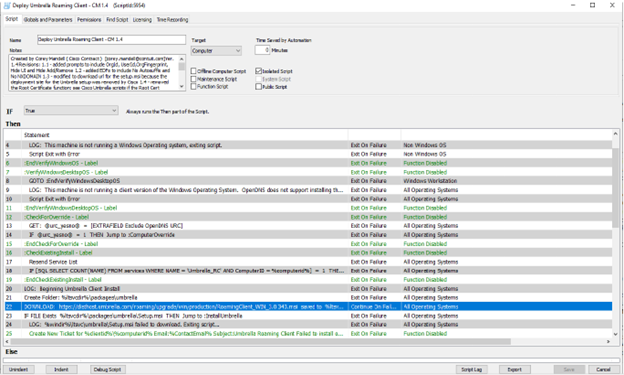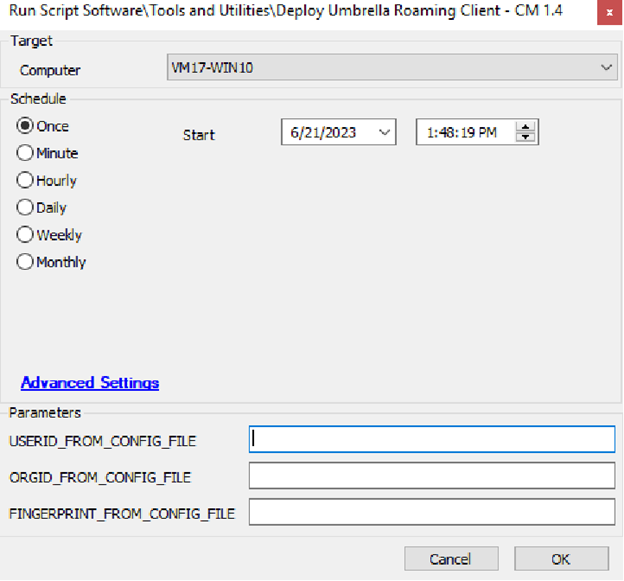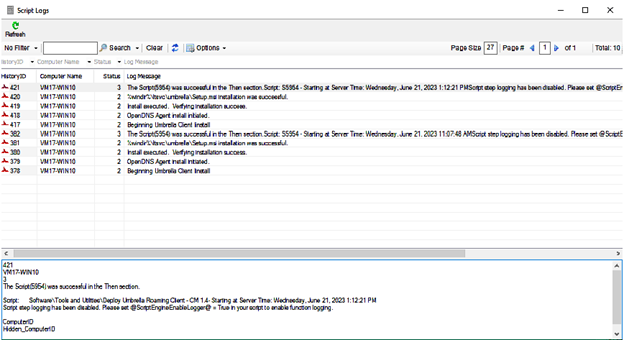ConnectWise Automate
Deploy Umbrella Roaming Client with ConnectWise Automate (Formerly Labtech)
Cisco Umbrella has Install and Uninstall scripts, and agent procedures for MSPs to deploy the Cisco Umbrella Roaming client using ConnectWise Automate. These scripts allow MSPs to import, set up system variables and install the Umbrella roaming client. However, Cisco does not provide comprehensive support for ConnectWise. For more information about ConnectWise Automate, see ConnectWise Automate documentation.
Note:
- We do not support the installation of the Umbrella roaming client on Windows Server operating systems.
- Review the Prerequisites and open all the appropriate firewall ports before running any deployment.
*Enter all customer internal domains before deploying the Umbrella roaming client. Failure to do so results in problems with accessing internal resources. For more information, see Domain Management.
Install Scripts
You can use Required and Optional parameters to configure the appearance and behavior of the roaming client on the Windows device. You are prompted to enter the parameters and the parameters are appended to the msiexec and executed using the shell command.
Required Parameters
Three parameters are required for the execution of the scripts and you are prompted for those values at run or schedule time. You can locate the appropriate deployment parameters in the MSP console on the Customer Management page by expanding the customer card:
- Organization Fingerprint
- Organization ID
- User ID
Optional Parameters
You can use the following optional parameters to change the appearance of the roaming client on the device or control the behavior of the client regarding the internal domains configured in the Cisco Umbrella dashboard:
- HIDE_UI: Hide the roaming client icon from the system tray of the Windows device to decrease awareness of the roaming client for the end-user.
- Values:
- 0 – show system tray icon (default)
- 1 – hide system tray icon
- Values:
- HIDE_ARP: Hide the roaming client from the Add/Remove Program list in Windows to prevent its removal by an end-user with admin rights.
- Values:
- 0 – show in list (default)
- 1 – omit from list
- Values:
- NO_AUTOSUFFIX: Do not add domains present in the DNS Suffixes settings in network adapters and networking properties to the Internal Domains list. This parameter is to make the roaming client more aware of local resources and domains on foreign networks.
- Values:
- 0 – add the domains (default)
- 1 – do not add the domains
- Values:
- NO_NXDOMAIN: If a DNS query sent to Umbrella returns an NXDOMAIN, query the local DNS servers.
- Values:
- 0 – query local DNS servers (default)
- 1 – do not query local DNS servers
- Values:
Uninstall Scripts
The uninstall scripts are simple automated scripts that execute a shell command “wmic product where name=’Umbrella Roaming Client’ call uninstall”. This method was sourced from Umbrella Support.
Using the Scripts
To use the ConnectWise Automate scripts:
- Launch the ConnectWise Automate Control Center.
- Navigate to System > General > Import > XML Expansion.
- Select the required XML script and upload it.
- Navigate to Automation > Scripts > View Scripts > Scripts.
- Search for Umbrella, right-click on Deploy Umbrella Roaming Client - CM 1.4, select Send
to > Script Folder and go to the folder where you want to save the script. - Browse to the folder where you saved the script, right-click on the script name, and select
Open. - Ensure you are using the latest MSI installer link. Double click line number 22 in the script, if you
need to edit the MSI link.

- To make sure you are deploying the latest Umbrella Roaming Client version, browse to
https://disthost.umbrella.com/roaming/upgrade/win/production/manifest.json, take the
"RoamingClient_WIN_version.msi" and replace {filename} in the link:
https://disthost.umbrella.com/roaming/upgrade/win/production/%filename% .
An example of a working MSI link is given below for your reference.

- To view the Umbrella Roaming icon in the Control Panel and in the tray, double click on line
number 29 of the script and remove the HIDE_UI=1 HIDE_ARP=1 parameters.

- Save the changes, if any.
- Browse to the target device. Click Scripts and browse to where you saved the Deploy
Umbrella Roaming Client - CM 1.4 script. - Enter the OrgID, UserID, and FingerprintID of your org. You can get this information from the
child-org, under Deployments > Roaming Clients > Download Module Profile. You will
get an OrgInfo.json file that contains all these parameters.

- Log into the ConnectWise Automate instance on your browser.
- Go to Browse > Scripting and ensure that the Deploy Umbrella Roaming Client - CM
1.4 is set to Enabled.

- To verify if the Umbrella Roaming Client has been deployed, go back to the ConenctWise
Automate Control Center instance, under Automation > Scritps > View Scripts > Scripts > Deploy
Umbrella Roaming Client - CM 1.4. Right click, open the script log and see if the Umbrella
Roaming Client is installed.

- Alternatively, you may remote into the given device and run the command: nslookup -q=txt debug.opendns.com. You should get the correct OrgID as output and if you browse to welcome.umbrella.com you should see a green check mark.

Updated 9 months ago
